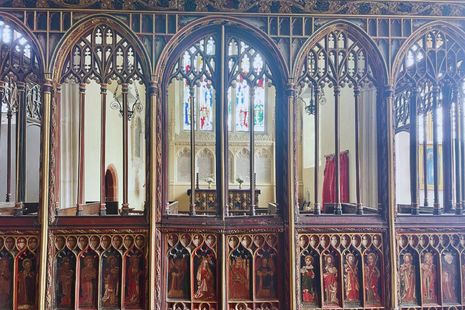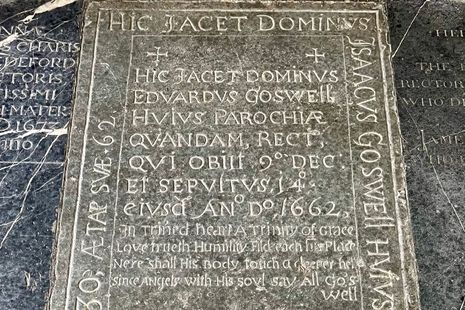Befriending the bygone, one church at a time
Drawn to these spaces while in Cambridge, Niall Quinn takes to church tourism during the summer break

“Dong. Ding … Dong …” pierces the morning’s silence. For some, it is a call to worship. For others, including myself, it signifies that yet another week is drawing to a close. A part of life’s very rhythm, the ringing is usually a reassuring constant. But not today. Because I am trudging through the depths of rural south Devon, a solitary toll is more of a relief than an expectation. It is a proclamation that I will not be flying home by moorland rescue helicopter; that civilisation remains within hearing distance.
This sound has been ringing in my ears over the past couple of weeks. In an effort to touch some grass, I have been gallivanting across the West Country’s (my home region) tors and valleys this summer – all the while attempting to avoid aggravating any farmers. But I have done so with a twist. Rather than merely travelling from nice pub A to nice pub B, I have placed churches at the heart of my adventure.
“Churches have strengthened my understanding of Cambridge’s history”
Why? In truth, because of my time in Cambridge. There, churches and chapels are in abundance, as is time spent in and around them. I established a routine where I would, after finishing a study session, pop my head into the nearest one. And I do not regret it. From stained glass to memorial slabs, the objects housed in these spaces have strengthened my understanding of the people who have inhabited Cambridge over the centuries. In short, this routine has bolstered my familiarity with the city. Rather than a place where I merely sit in libraries and (attempt to) think, it feels like more of a home than it did beforehand.
Applying this strategy to my grass-touching attempt, a similar effect has occurred. When frolicking around rural areas, one village is more or less the same as the next. On previous ventures in south Devon, each pit-stop I made in a (typically pub-less) settlement was a rather liminal, impersonal affair. But today, as I stumble toward the porch of Holy Trinity Church, Torbryan, I feel assured that old habits will not die hard.
As I’m surrounded by some thatched cottages, a farmyard or two, and a private-use-only inn, describing Torbryan as remote would be a gross understatement. This remoteness, however, immediately abates as I enter the Perpendicular Gothic masterpiece. Constructed in just twenty short years (1450–1470), the building’s very physicality acquaints one with its long-lost community. Surprisingly, the porch’s ceiling is adorned with elaborate fan vaults. Fan vaulted ceilings are usually found in large, wealthy churches, such as King’s College Chapel. To find one in as desolate a place as Torbryan, therefore, is staggering. The pride and hope the people of Torbryan must have had in their new church oozes from the vault’s ribs.
“The building’s very physicality acquaints one with its long-lost community”
As I pass into the nave, the heart of the church, the 554-year-old social and devotional fabric of the community is thrown upon me. But the magnificent 15th century painted rood-screen – the loom, if you will – prevents any loitering. Dividing the chancel from the nave, the screen is made alive by the 40 saints it displays. From St Apollonia, patron of toothache, to the Coronation of the Virgin, the diverse world of late medieval communal devotion shines through their pigments.

So too, however, does the tumultuous world of Reformation England. If one squats and inspects them closely, traces of iconoclasm begin to emerge: a few gouged eyes here, some jagged scratches there. There is no better example of these changes than the ledger slab just before the high altar. Once a part of the medieval stone altar, it was probably removed during the reign of Elizabeth I – when such altars were replaced by wooden communion tables. Through this final mark one gains a glimpse of a social environment, at its very heart, being shaped by (and shaping) the spirit of their age. But for all the stark communal change these artefacts frame, universal human concerns triumph.
“Future generations will preserve churches as totems of human activity”
Nearby, “Volat irrevocabile tempus” is etched beneath a harrowing skull. If my very limited knowledge of Latin does not fail me (have mercy upon me, classicists), this phrase means “time flies irrevocably”. When I tripped over a cowpat this morning, I certainly did not anticipate that I would end up pondering deeply on the futilities of procrastination and the imminence of death. I deleted TikTok shortly afterwards.
Yet herein lies a reason for the preservation of churches like Torbryan. Life is transient; communities, Torbryan included, fade and evolve. All the more important is leaving such spaces to future generations, who will preserve them as enduring totems of human activity. This truth is particularly relevant for Torbryan, for it is no longer used for regular worship. Instead, it is managed by the Churches Conservation Trust (CCT). Alongside similar organisations, the CCT’s work ensures that these otherwise endangered spaces allow visitors to contribute to their totemic status.
My visit to Torbryan has reconfirmed the value of encountering rich stories through ‘church tourism’, whether for worship, sating antiquarian curiosity, or both. In many areas, particularly rural ones, churches remain the only container of the full scope of a community’s history. They are, therefore, a gateway to establishing a personal, human connection with a place. If advocating for this makes me a tourist, then so be it.
 News / Downing investigates ‘mysterious’ underground burial vault 29 December 2025
News / Downing investigates ‘mysterious’ underground burial vault 29 December 2025 News / Unions protest handling of redundancies at Epidemiology Unit30 December 2025
News / Unions protest handling of redundancies at Epidemiology Unit30 December 2025 Lifestyle / Ask Auntie Alice29 December 2025
Lifestyle / Ask Auntie Alice29 December 2025 Features / ‘Treated like we’re incompetent’: ents officers on college micromanagement30 December 2025
Features / ‘Treated like we’re incompetent’: ents officers on college micromanagement30 December 2025 Science / Astronomical events to look out for over the break29 December 2025
Science / Astronomical events to look out for over the break29 December 2025










